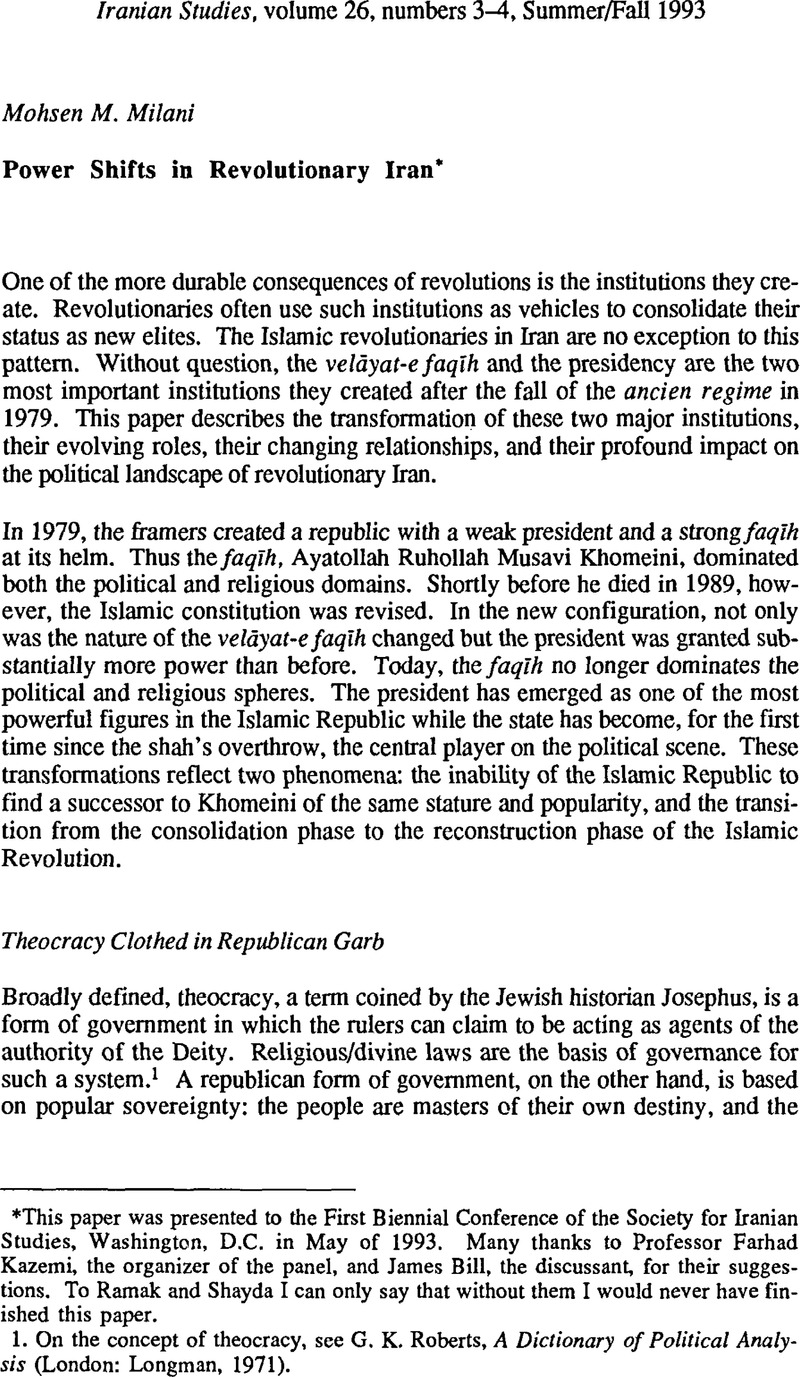Published online by Cambridge University Press: 01 January 2022

This paper was presented to the First Biennial Conference of the Society for Iranian Studies, Washington, D.C. in May of 1993. Many thanks to Professor Farhad Kazemi, the organizer of the panel, and James Bill, the discussant, for their suggestions. To Ramak and Shayda I can only say that without them I would never have finished this paper.
1. On the concept of theocracy, see Roberts, G. K., A Dictionary of Political Analysis (London: Longman, 1971)Google Scholar.
2. Ṣūrat-e mashrūḥ-e moẕākerāt-e barresī-ye nahā'ī-ye qānūn-e asāsī-ye Irān (Tehran, 1986), 1:5 (henceforth Barresī).
3. Khomeini, R., Hokumat-e Eslamlya velayat-e faqih (Najaf, 1969), 7–9Google Scholar.
4. In the first phase of that movement, Khomeini spoke of creating an Islamic government. As the movement neared victory around November 1978, he advocated an Islamic republic, which allowed him to mobilize all the anti-shah groups under his own banner. See Khomeini, R., Nedā-ye ḥaqq (Tehran, n.d.), 1:20, 41–2Google Scholar.
5. See, for example, Nedā-ye ḥaqq 1:35, 48.
6. Cited by Bakhash, S., “Islam and Social Justice in Iran,” in Shi'ism, Resistance, and Revolution (Boulder, 1987), 113Google Scholar.
7. For details see M. M. Milani, “The Evolution of the Iranian Presidency,” The British Journal of Middle East Studies (forthcoming).
8. Barresī 1:38.
9. Constitution of the Islamic Republic of Iran, translated from the Persian by H. Algar (Berkeley, 1980), 29.
10. Barresī 1:73.
11. Ibid., 54.
12. This point is explicitly made in Zanjani, ‘Abbas ‘Ali, Mabānī-ye feqhī-ye qānūne asāsī-ye jomhurl-ye Irān (Tehran, n.d.), 19Google Scholar.
13. Barresi 1:1213.
14. Ibid., 1195.
15. For details see M. M. Milani, “The Transformation of the Velayat-e Faqih Institution,” The Moslem World 82, nos. 2–3 (July-October 1992):.175–90.
16. Milani, M. M., The Making of the Islamic Revolution (Boulder: Westview Press, 1988)Google Scholar, chap. 10.
17. Bani-Sadr, A. H. Kheyānat-e be omid (Paris, 1982), 117Google Scholar. For a different perspective see Chegūnegī-ye entekhāb-e avval'īn nakhost vazīr-e jomhūrī-ye Eslamiye Irān (Tehran, 1982).
18. Kalām-e emām, vol. 5 (Tehran: Amir Kabir, 1982), 81.
19. Ioannides, C. P., America's Iran (Washington, D.C.: University Press of America, 1984), 66Google Scholar.
20. Bani-Sadr, Kheyānat, 19Google Scholar.
21. See Amirahmadi, H. Revolution and Economic Transition (New York, 1991)Google Scholar.
22. Ṣūrat-e mashrūḥ-e moẕākerāt-e shūrā-ye bāznegarī-ye qānūn-e asāsī-ye jomhūrīye Eslāmī-ye Irān (Tehran, 1989), 1:196 (henceforth Bāznegarī).
23. The Constitution of the Islamic Republic of Iran (Tehran, 1990), 62.
24. Bāznegarī 1:196–7.
25. Ibid., 192, and 3:1256.
26. The Constitution of the Islamic Republic of Iran, 62–4.
27. Bāznegarī 2:679.
28. Bāznegarī 1:196–7.
29. Ibid., 1210–11.
30. Bāznegarī 1:268.
31. Iran Times, 16 June 1989.
32. Personal interview (Tehran, July 1991) with Fazlollah Tavakkoli Bina, adviser to the president for economic affairs and trade unions and one of the founding members of this organization; personal interview (Tehran, July 1991) with Ayatollah Anvari. Anvari was jailed by the shah's regime for having issued the fatwā to assassinate Mansur, a charge he denies.
33. Iran Times, 1 October 1993.
34. Washington Post, 18 August 1989.
35. Iran Times, 16 June 1992.
36. See Milani, M. M., “Iran's Active Neutrality During the Kuwaiti Crisis,” New Political Science, nos. 21–22 (Spring/Summer 1992): 41–60CrossRefGoogle Scholar.